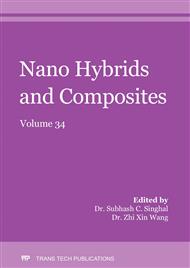p.17
p.23
p.29
p.37
p.47
p.53
p.61
p.71
p.77
Fabrication of Fluorite and Perovskite Functional Films by Solution Spray Pyrolysis
Abstract:
Solution Spray Pyrolysis (SST) was successfully implemented to fabricate thin perovskite and fluorite films on dense Yttria Stabilized Zirconia (YSZ) and Lanthanum Strontium Ferrate (LSF70) substrates. These composite structures are ubiquitous in solid oxide fuel cells and electrolyzers, CO gas sensors and ceramic membranes. With this technique, successful in situ manipulation of the film’s functional characteristics such as porosity and thickness is easily achieved by adjusting its functional parameters.In the present contribution, we report on the optimization of the physicochemical parameters of this open atmosphere technique with respect to the substrate temperature and deposition time for the fabrication of films of suitable morphology. Sintered films were characterized by XRD and SEM while thermal analysis was performed on the precursor salts. In addition, AC Impedance analysis was performed on some CGO films in order to assess their electron blocking capability in contact with the LSF substrates.
Info:
Periodical:
Pages:
47-52
Citation:
Online since:
February 2022
Keywords:
Price:
Сopyright:
© 2022 Trans Tech Publications Ltd. All Rights Reserved
Share:
Citation:


